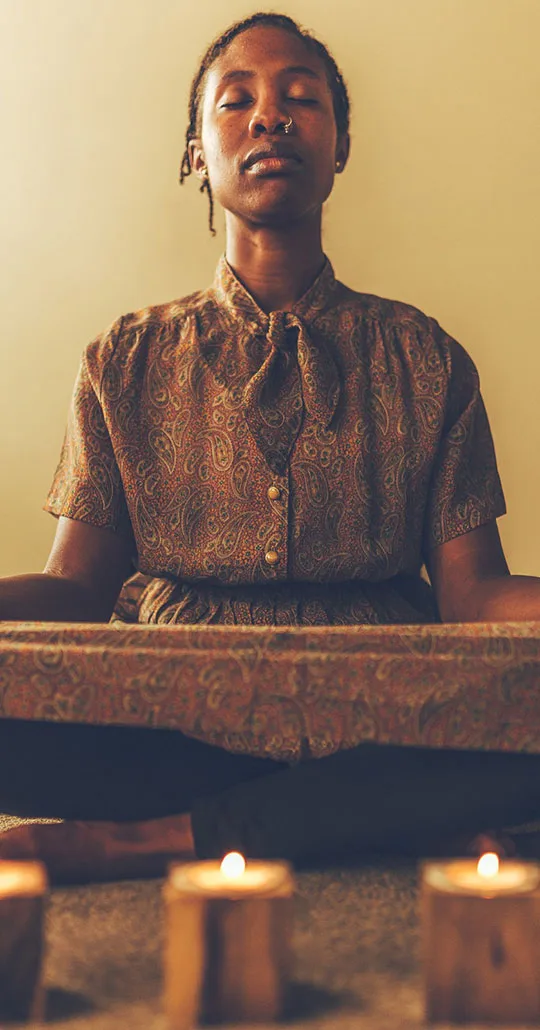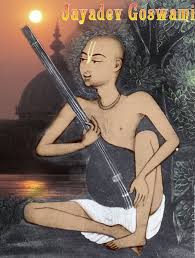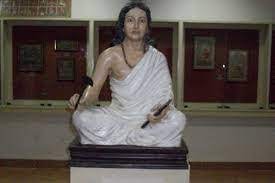So, the question is that due to various experiences in life where the mind has become become somewhat averse to everything mundane, I feel attracted more to the impersonal and there are also statements from scripture which seem to point toward it. Like there’s that absolute has not a sampati maasti or naithi naithi. There’s something more beyond this. This is not the ultimate. So, see first is that we need to always look at ourselves positively.
Ultimately, we are our only asset. In the sense that, just as we need to have a healthy relationship with others, similarly, we need to have a healthy relationship with ourselves. And that means, we need to understand that this is where I am at and appreciate that this far we have come. So, for example, if we have had bad experiences in relationships and interactions with people, it is, we could react to that in 3 broad ways. In sattva, rajas, and tamas.
In tamas, one can become hateful of the whole world, or one can just start feeling sorry for oneself. And just it becomes some people just burning with resentment and anger and hatred. They can’t don’t do anything about it, but just as soon as they start talking, there’s so much poison in their heart that comes out. So in general, everyone gets a raw deal in life. And of course, some people may suffer much more than others, no doubt about it.
But everyone gets feels that I have not been treated properly by others. That feeling is there, but more importantly is how we respond. In rajaogona, the person becomes very power hungry, where I will become so strong that no one will be able to mess with me in the future. And then, they just that becomes their single-minded quest. And unfortunately, power doesn’t really fulfill that promise or address that need, but that becomes one reaction.
In Sathva, one starts realizing that actually what I’m looking for is not only to be found in this world and in the relationship with the people in this world. There has to be something more in life. So, in one sense, detachment and resentment are very opposite. Resentment is, I don’t want things to be like this, but I don’t have the power to do anything about it. So I’m burning inside.
I can’t do anything to change these things. But detached so resentment is more like, I am not good enough for the world. That is resentment. Detachment is the world is not good enough for me. There has to be something more to life.
So broadly, even if one is attracted to the impersonal, it is, if it is not filled with too much negativity toward the world and toward the people in it, then that is a sattvic reaction. If it is filled with too much negativity toward the world, then that could be tamasik. And then the key to that is try to cultivate more sattva kona. I read more about how everybody in life goes through difficulties, and that we need to work to go beyond those difficulties. So by that we learn and grow.
That’s one aspect to it. Okay? So to have a positive relationship toward yourself means see that whatever we have come to is a good place. We come to sattvic level of realisation. And now, beyond that, what is the nature of the ultimate reality?
That there is something beyond this world. And what is it? So, if anyone gets any understanding, there has to be something more beyond this. That is auspicious thing. Krishna in 6/14, the Bhagavita says that such people are kalyana krut kashit.
That you know, there are such few people, not many who can do this. They are kalyana krut. They are engaged in auspicious work. And this includes all kinds of seekers, not just bhakti yogis, but even gyan yogis, dhyana yogis. Anybody who is seeking something beyond this world is well situated.
And Krishna says such people will never meet within auspiciousness. That neither in this world nor in the next world will they ever meet with destruction and nor will they meet with any inauspiciousness. So, appreciate that the experiences of your life have brought you to a positive place where you have become detached from the things of this world and you are focused on something higher. Now, regarding the nature of the higher, at this point, it is possible that our understanding may be more reactionary than revelatory. Revelatory means we have got some higher experience.
Revelation Not revolution, revelation. Revelation means it is some realization, some higher experience. So revelation. And reactionary means based on the reaction to what has happened to us in this world. These 2 are very different things.
So when it is reactionary, at that time, it is not very healthy. Because it’s often some people have had bad experience with dogs. Suppose some dog has bitten them. They hate all dogs. I’ll never have a dog as a pet.
Okay. That’s good. There’s no need for a pet research in life. But that doesn’t mean all animals are bad. Doesn’t mean all dogs are bad.
So reactionary is little short sighted. It may be based on what we have experienced in life, but reactionary conceptions. You did this to me, so I’ll do that to you. So, reactionary conceptions are not very evolved. That is how, hatred and biases and prejudice happen.
You know, you did this to me like this, your family did this to me, therefore I will destroy your entire kul. And hate wars start like that. So at this stage, it is possible that our conception of the spiritual may be based a little bit more on reaction. So, rather than worrying too much, is it that right now I don’t feel attracted towards the personal and the spiritual and the personal activities over there? So don’t worry too much about that lack of attraction.
Right now, we’re just moving from the material towards the spiritual. So don’t see that you are following this path or that path. The difference between personal and impersonal, it is important, but when we are caught in the material world, that may not be the most important thing. See, we can understand that there is some higher reality that is guiding our life. Isn’t it?
So that is not very difficult to understand. So now whether that higher reality is personal, impersonal, let’s put it aside. There is some higher reality guiding our life and by that higher reality we have come to some spiritual path. So rather than thinking I am following this path, think that it is that higher divinity that has opened this path for me. Let me explore this path right now, diligently.
And if this path is right for me, well and good. If this path is not right for me, I’ll get that understanding. So, the desire to be alone or the desire to not want to engage in activities, that could be possibly an indication of our deep inner inclination itself, or it could be just a result of the kind of people we have met and the kind of experiences we have had with people. We don’t know which one it is right now. So let’s be open and focus more on just moving ahead in life.
So continue the path you are following and just be open to what experiences come, what realizations come, how we move forward. So, over a period of time, that same ultimate reality, same God who has brought us here will take us ahead from here also. To this point where we have been brought, from this point we will be taken ahead. That’s one side of it. Now the other side of it will be that as far as scriptural statements are concerned.
We can discuss them more in detail, but I’ll just give some broad ideas. See the Naithi, Naithi is generally to move from the material toward higher reality that the forms of this world are not the ultimate thing. The taste of this world are not the ultimate thing. There has to be something more in life. So now, does that pen and the forms of the spiritual world also fall in that category?
Maybe, maybe not. The key difference is that when we have no experience of a spiritual form right now. We have no experience of spiritual activities. We may come to a temple and we may feel a little peaceful, we may feel a little nice, but what is actually spiritual love? That is a very different experience.
Because right now, almost all the relationship that we have experienced have some level of selfishness within them. And to have experienced relationship beyond, this is not easy. So that’s why rather than making a categorical decision about what we want to do, just continue on in your practice right now. And if you continue on that practice, then it will be revealed to you. So with respect to, naithi means that what we have in this world, there is something more than that.
Now, in the scriptures only, where there are descriptions, for example, of this world being false, forms being false, in those same scriptures there is also description of some higher reality. There are great saints who are worshipping a form. There are of course, impersonalists, but there are also saints worshipping a form. Isn’t it? So there are both conceptions of reality that are described.
And natasya pratimaasti. Now what does that mean? Pratima is a representation. So with respect to the spiritual and the material, there are 2 different connections or with respect to God and forms in the world. There is a representation and there is a manifestation.
They are 2 different things. So in the Chetan sartham there is verse pratimanahitumi sakshatvajendraannam. That is prayers being made to the deity, you are not a pratima. You are actually the Lord Himself. So, what is the meaning of a Pratima?
This is a built conceptual. I’ll try to explain it. See, there are two kinds of representations. There is bottom up and top down. Bottom up means what?
See the concept of nationhood. Say India love for India patriotism. Now feel patriotic. You tell them, someone. How do you feel patriotic?
There has to be some symbol. So we have the flag. We see the flag, we salute. Right? Saluting is a way, saluting the flag is a way of expressing the emotion.
So now, emotion is inside us and the concept of nation or it’s it’s a little abstract. We have a physical map. But you know, we don’t look at the map and salute the map. We need some representation. For the flag is Indian flag is for example having 3 colors.
Now if tomorrow India becomes very industrially progressed, or we become more of a service economy, we may decide that, no, we don’t want the green colour in our flag. Because the we are not so much of a economic we are not so much of a farming economy. Now we may decide we want to have some other colour, say, a white colour which indicates or a black colour which indicates technology. I assume. So now can we change the colour of the flag?
We can, you know. Does the Indian government have to pass a resolution? The color of the flag will be changed. So the connection between the flag and the country, that is a result of the human imagination. There is no intrinsic connection between the America has a particular flag.
They can change the flag by a by a resolution of their parliament. So there are some symbols which can be changed. So your our school might have a particular sim symbol. Like, there are people who are in branding companies. A company is a particular logo.
When you see the logo, we remember that company. But some of the company want to rebrand themselves. They’ll change their logo. So between the logo and the company, there is no intrinsic connection. The logo can be changed.
The company will still remain the same. This is one kind of symbolism. And this is referred to as pratima. Pratima means, there is some abstract reality which we can’t really connect with, and so we have a symbol. We have some representation, some image which connects the 2.
But there is another kind of representation. Let’s say the photo of a person. Now the photo of the person is not exactly the person. You cannot talk with the photo and the photo will talk back to you. But now if if, husband is working on a traveling job, and he comes back home and his wife is taking cleaning his clothes, she sees in his wallet, there is a picture of some other woman other than him.
What is this? Hey, you know, actually I am thinking of you only, but I skipped a picture of someone else. Now, that won’t work. Isn’t it? There is a intrinsic connection between the picture of the person and the person.
So, this is not a connection of imagination. So, when we talk about the deity of the Lord, the deity of the Lord is directly connected with the form of the Lord. So, it is not a pratima and the word used for this is vigraha. So, pratima and vigraha, they are like the difference between representation and manifestation. So, pratima is representation and one thing can have some pratima and pratima can be changed, but the manifestation is not the pratima.
Manifestation is directly that person appearing in a particular way over here. So, when the scripture says that, no, natya satyapati maasti. What it means is don’t represent that higher reality in your own way over here. That don’t concoct the images of it. So that is a universal prohibition.
Don’t imagine how it is like. But when it is described in scripture, we can certainly build on that. So that way, it is a scriptural statement. There can be a lot of analysis that can be done. If you want, I have written a book on this topic called Idle Worship or Ideal Worship.
So, the idea of the form of God, the idea of can the ultimate reality have a form at all? All these things I have elaborately discussed over there. So, if you want you can have a look at that book also. But broadly speaking, it is that say somebody who is in, you are right now in junior college, assume. No, no, assume you are in junior college.
Then if there is 2 Nobel laureates who have 2 different theories of physics, you know somebody has quantum physics, one interpretation, somebody has another interpretation. The student in a junior college doesn’t really have to worry who is right right now. See, there is one famous physicist who said that, there is this kind of debate. He said, the opposite of a normal truth is a falsehood. It is true and it is false.
But the opposite of one great truth is another great truth. The other great truth is not a false. This is also true, this is also true, they are from different perspectives. So that the ultimate reality is personal is the truth. The ultimate reality is impersonal.
That is also truth. It is not that the absolute truth is only this or only that. It is both. So, right now you may not be attracted towards the impersonal more than the personal. But is this something on which you want to build your lifelong commitment?
Maybe, maybe not. Just focus on your spiritual growth right now. Like you are in junior college, in Physics, just continue on college, complete your junior college, complete your senior college. By that your understanding of Physics will improve and then you can decide whether this scientist theory is right or that scientist theory is right and you can commit at that time. Right now, don’t let it discourage you in your spiritual journey.
And in the spiritual group that we have, we can keep growing. Try to understand, it’s not accident that you have come to a particular path right now. It is by some divine arrangement and just explore this path and see how it helps you to grow as a person. How it evolves helps you evolve your understanding of the ultimate reality and then take whatever decision you want. Okay?
The post Personal or impersonal ? appeared first on The Spiritual Scientist.





 By Dandavats Staff Writer
By Dandavats Staff Writer By HH Badrinarayan Swami
By HH Badrinarayan Swami By Dandavats Staff Writer
By Dandavats Staff Writer From Wikipedia
From Wikipedia  By Dandavats Staff Writer
By Dandavats Staff Writer



 By Dandavats Staff Writer
By Dandavats Staff Writer By Dandavats Staff Writer
By Dandavats Staff Writer By Dandavats Staff Writer
By Dandavats Staff Writer